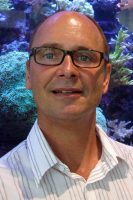
Beneath the clear, turquoise waters off the shores of Carrie Bow Cay, Belize, sponges and seaweed have taken up residence where coral once flourished.
The sponges that cover reef there — part of the Meso-American Barrier Reef — pump massive amounts of seawater, are a food source for various reef fish, and, as one doctorate student at the University of North Carolina Wilmington has discovered, certain species of sponge absorb toxic chemical compounds.
Supporter Spotlight
Lauren Olinger has spent more than two years researching several species of the most common sponges in the Caribbean that now thrive on the reef.
What she has discovered is that sponges with an abundance of microbes, or tiny living things too small to be seen by the unaided eye, “take up” significant amounts of compounds versus sponges that have a low abundance of microbes.

“From the compounds that these species were taking up, a lot of them were organohalides, so that means that they had halogen in them,” Olinger said in a recent telephone interview. “It’s interesting that an animal could use something that’s halogenated. These compounds can be really toxic. They can also include contaminants so there’s some interesting consequences there and it might tell us something about what these compounds are being used for.”
Organohalides include the elements chlorine and bromine, which are toxic in humans. They include many toxic pollutants, such as polychlorinated biphenyls, or PCBs, insecticides, and industrial byproducts.
UNCW professor Joseph Pawlik said Olinger’s research demonstrates, for the first time, that sponges can eat organic compounds that have halogens in them.
Supporter Spotlight
“These are classes of compounds that include many toxic pesticides and industrial solvents,” he said. “We’re not saying that it’s taking those up. We’re just saying that we know they’re taking up organohalides. We can identify the molecules well enough. We don’t necessarily have absolute identification of the compounds and that’s a matter of the technique that’s being used to identify compounds that are found in very, very small concentrations. The next stage of Lauren’s work is to actually identify some of those compounds.”
Sponges are actually known for consuming dissolved organic carbon, an unusual food source for animals. But dissolved organic carbon, or DOC, can be up to 90% of what a sponge eats, Olinger said.
Olinger and her colleagues dived and collected seawater going into and coming out of sponges along a reef system off the small island on which the Smithsonian Institute’s Carrie Bow Cay Field Station is located, about 15 miles offshore.
Those samples were taken to the field office and prepared for analysis back at UNCW, where dissolved organic matter, or DOM, included in those samples were analyzed.
Olinger’s research is being published in Frontiers in Marine Science.
A hypothesis referred to as the “sponge loop” suggests that sponges benefit coral reefs by taking up DOM and converting it into their own bodies.
“If sponges are converting this carbon into something that other animals could use then this could be simulating the reef because, on coral reefs, they’re really desert-like,” Olinger said. “There’s not a lot of nutrients there.”
Yet, the ever-growing presence of sponges on reefs, including the coral reefs of the Florida Keys, are not necessarily a good sign.

“What we’ve seen over the course of the last several decades is that reefs are being taken over more and more by sponges in addition to seaweeds and the one species that seems to be doing particularly well that grows very large is the giant barrel sponge, which gets to the size of small car,” Pawlik said. “The positive thing about sponges, unlike seaweeds, they do provide critical habitat for fish, lobster and all the other things that human beings like to eat. But, they don’t build calcium carbonate reefs. So, over long periods of time reefs are going to disappear. Sponges cannot persist in storms, in hurricanes the way coral reefs can. It’s just not as strong. That’s why sponges are a poor substitute in the end.”
If sponges are allowed to thrive in these environments, Olinger said, that will make it harder for corals to recover or come back in and grow.
Sponges simply cannot replace coral, but their importance to the sea is undeniable.
“If we find that a certain species of sponge does something important to seawater or has a change in the seawater or eats something out of the seawater, that’s really important,” Olinger said. “If there’s a contaminate there could be applications for using that sponge as a bioremediation. That’s super out-there, but it’s an idea. Otherwise, there’s a whole level of things that eat sponges and that if we know if sponges are doing something good for the environment like recycling carbon, then we could make a stronger case for protecting the fish that eat them so that we can maintain a more healthy environment.”







